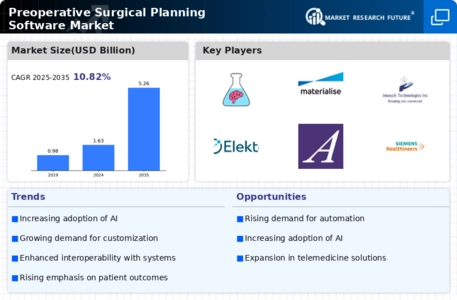Increased Surgical Volume
The rising volume of surgical procedures across various specialties is a key driver for the Preoperative Surgical Planning Software Market. As surgical techniques advance and the population ages, the demand for surgical interventions continues to grow. Reports indicate that the number of surgical procedures performed annually is expected to increase by 10% over the next five years. This surge in surgical volume necessitates efficient planning tools to ensure optimal outcomes and resource management. Consequently, the Preoperative Surgical Planning Software Market is poised for growth as healthcare providers seek to streamline their surgical workflows and enhance patient safety through effective preoperative planning.
Growing Focus on Surgical Outcomes
The heightened focus on improving surgical outcomes is driving demand within the Preoperative Surgical Planning Software Market. Healthcare providers are increasingly recognizing the importance of meticulous preoperative planning in reducing complications and enhancing recovery times. Studies have shown that effective surgical planning can lead to a reduction in postoperative complications by up to 30%. This awareness is prompting hospitals and surgical centers to invest in advanced planning software that facilitates better decision-making and enhances surgical precision. As the emphasis on quality of care continues to grow, the Preoperative Surgical Planning Software Market is expected to expand in response to the need for tools that support superior surgical outcomes.
Integration of Artificial Intelligence
The integration of artificial intelligence (AI) into the Preoperative Surgical Planning Software Market is transforming surgical planning processes. AI algorithms can analyze vast amounts of patient data, including medical history and imaging results, to provide tailored surgical plans. This capability not only enhances the precision of surgical interventions but also reduces the time required for planning. According to recent estimates, the AI segment within the surgical planning software market is projected to grow at a compound annual growth rate of over 25% in the coming years. As healthcare providers increasingly adopt AI-driven solutions, the Preoperative Surgical Planning Software Market is likely to witness a surge in demand for these advanced tools.
Rising Demand for Personalized Medicine
The growing emphasis on personalized medicine is significantly influencing the Preoperative Surgical Planning Software Market. Surgeons are increasingly seeking software solutions that can accommodate individualized patient data, leading to more effective surgical outcomes. This trend is driven by the recognition that each patient's anatomy and medical history are unique, necessitating customized surgical approaches. The market for personalized surgical planning tools is expected to expand, with projections indicating a potential increase in market size by approximately 15% annually. As healthcare systems prioritize patient-centered care, the demand for sophisticated preoperative planning software that aligns with personalized medicine principles is likely to rise.
Regulatory Support for Surgical Innovations
Regulatory bodies are increasingly supporting innovations in surgical technologies, which is positively impacting the Preoperative Surgical Planning Software Market. Initiatives aimed at expediting the approval process for new surgical tools and software solutions are encouraging manufacturers to invest in research and development. This regulatory environment fosters innovation, leading to the introduction of advanced preoperative planning software that meets evolving clinical needs. As a result, the market is likely to experience accelerated growth, with new entrants and established players alike striving to comply with regulatory standards while delivering cutting-edge solutions to healthcare providers.


















Leave a Comment